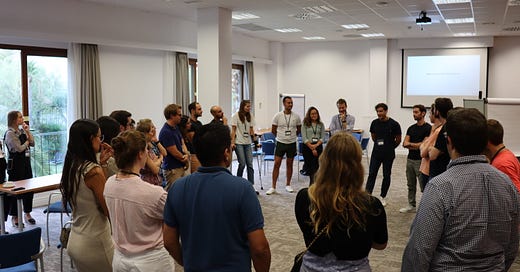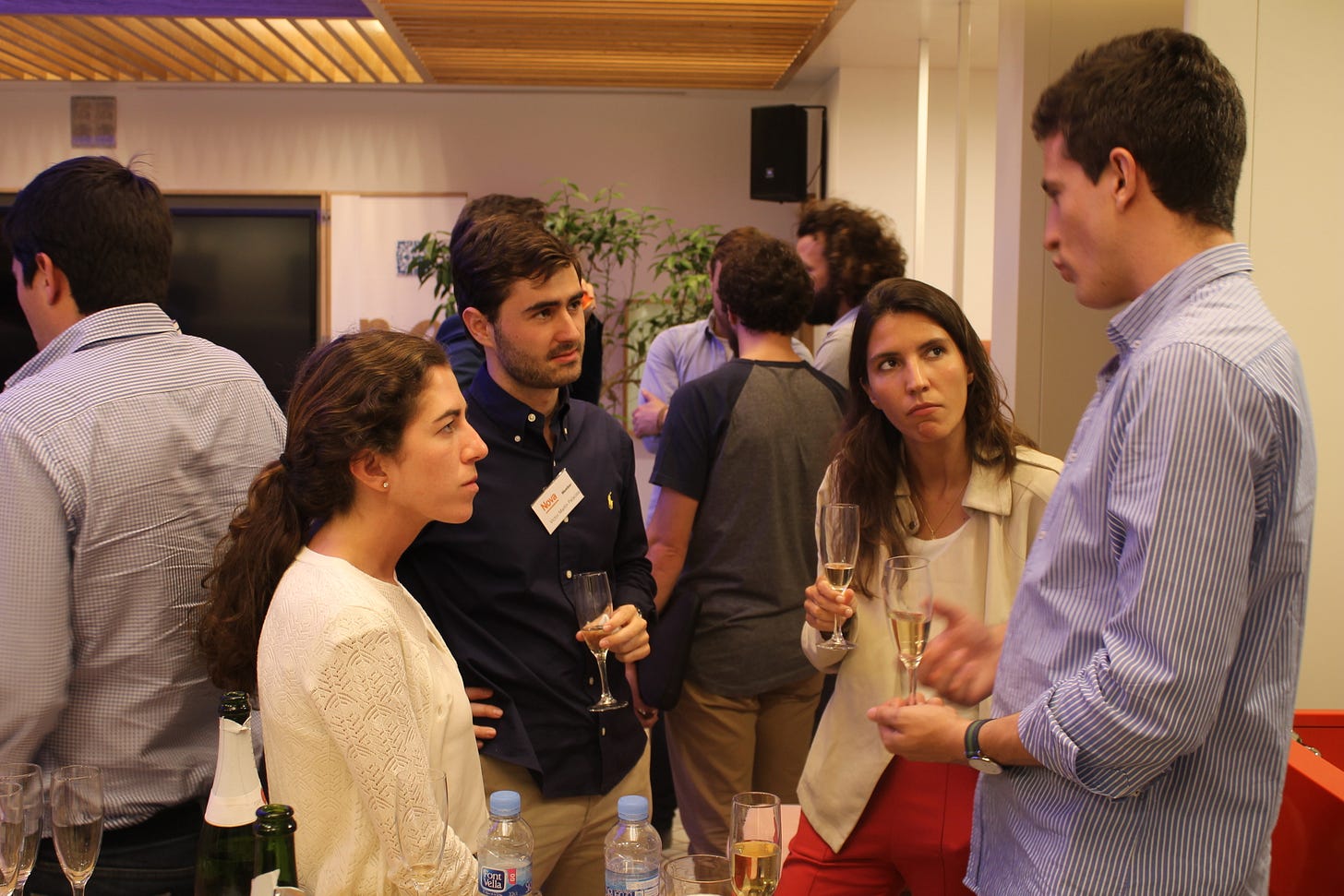How to Build Trust | A Series on Community Building (1/3)
In this edition, we get to the heart of Nova’s mission exploring how we have started and grown a global top talent community.
Summary
🔎 What did we learn from building a global community? - We dive deeper into the initial phase of building the Nova community and the early lessons we took with us.
🌟 If you are not a Nova member, for reading until the end, we reward you with a direct nomination to the network where you can test yourself by completing the assessment process.
In the previous editions, we have discussed how we improved our operating model to increase efficiency and profitability as well as our journey to build a global leading brand, you can access all our previous editions here.
Today 20.000+ top talented individuals recognize themselves as Nova members, an achievement that seemed impossible when we got started with the first small gatherings and dinners. With this edition, we start a series focused on community building hoping they can serve as an inspiration for all the community builders out there. We believe some of the principles will apply to other areas of your business.
Saying that the Nova community is our most valuable asset is an understatement. Nova started with a clear vision, building a community where top talent from all socio-economical backgrounds can meet each other and together reach their full potential. Building a community is our reason for existence.
We fundamentally believe that the world needs a merit-based meeting place for the most brilliant individuals. History serves as an inspiration, the most productive and inspiring historical eras, were the results of thinkers, artists, and philosophers converging in certain regions or cities, that “talent density” and the exchange of perspectives have always been the most important factors that moved the world forward, think of the Renaissance.
Paradoxically, we live in a time when it’s harder than ever to find global communities where to belong. On the one side, you can find local communities, many of which we admire and belong to ourselves, that don’t have the tools to scale beyond a certain reach, and on the other side, massive tech platforms that don’t foster any sense of belonging. You can take LinkedIn or Instagram as an example to realize that while it gets easier to connect or follow each other, it gets progressively harder to build trusted relationships at scale.
This is where we see Nova changing the paradigm. A merit-based community that preserves the trust of local communities but enables it to scale via the latest technology available. A community where access is not granted based on who you know, or where you are from but on your potential, skills, and achievements.
As any community, we have been local at the start and we have done a lot of the things that don’t scale, so in this article, we start by sharing 3 key insights we have learned on the journey of turning a local community experiment into the global top talent network Nova is today.
1. When starting a community “Do things that don’t scale”
The early days of Nova can be summarized in a few words, which inspired us a lot: No one “builds a house.” They lay one brick again and again and again and the end result is a house. A remarkable, glorious achievement is just what a long series of unremarkable, inglorious tasks looks like from far away. Source: Tim Urban
When we launched Nova in Spain, we did it through a lot of manual work and non-scalable processes. The first 100 members were contacted and interviewed individually over in-person coffees. While that took a lot of time and effort, it has been instrumental in our future success. During the process, we learned a lot about what our potential members wanted as well as what type of communities we had to build to attract the most talented people in the world.
The best part of it all, is that still today with a fully functioning tech platform and an established brand, when launching in a new market, we go back to the manual playbook. We still identify and talk individually to 100 founding members, we listen to their aspirations, and pain points and we involve them in shaping the country network together.
As a part of the same insight, our community was initially organized on a Facebook Group, which reached a very high level of daily engagement. Initially, we didn’t build any community platform ourselves. The next step was to move to a white-labeled solution, that allowed us to increase the sense of belonging, improve our data structure but most importantly start testing and observing how members interacted and therefore what kind of platform we were meant to build.
It wasn’t until 2022 that we started with building our community platform condensing all the learning of the non-scalable activities we’ve done. Guess what, our members love the simplicity of the current platform and we have a MAU% that is comparable to Linkedin without having yet launched a mobile app and using push notifications.
2. All you need is trust
You might be more familiar with “all you need is love”, and to some extent to build a community you need that too. However, from the get-go, we knew one thing, to build a community that attracts the most talented people in the world we had to build a community based on trust. We saw a clear pain point with professional communities that reached a high scale, they gradually turned into digital markets where people tend to go to buy and sell services of all kinds. This erodes the trust and quickly transforms what was before a tight community into a spam experience.
This is why, among the many ingredients that have contributed to building Nova into a global community, trust has been the most important one. Trust is the common denominator that ensures our members show up to events even when they don’t know anybody, makes them feel safe to nominate their colleagues to join the network, or when they apply and invest their time to complete the assessment process.
So the big question is, how did we build trust as a small and unknown community when we first started? The answer is in our selection process.
It was initially counterintuitive, why would we create a massive friction when we were still such a small community of a few hundred members?
The selection process created instant trust, it showed that we were walking the talk. Nova was all about merit and we were very serious about it, nobody could hack the system and become a member without going through the application which still today requires 30 minutes in between background assessment, logical reasoning test, video interview, and references.
While the process undoubtedly slowed our growth in the beginning it enabled us to curate the community in a way that the initial sacrificed speed paid back a few years later by contributing to a clear brand positioning and a high-integrity platform. This turned into a significant acceleration in organic nominations which made Nova reach 18.000 members without a single euro invested in marketing.
When building your community, make sure you use trust as a key ingredient. Think about what your community stands for and how you can establish a credible foundation for that.
A curated community is by definition not for everybody, so to reinforce trust never be afraid to add small points of friction being that in the sign-up process or to unlock certain rights and features. Those friction points can sometimes be a short motivation letter or a reference, just make sure that the solution you use aligns with your community’s vision and mission, when that happens what you gain outweighs what you lose in the long run.
3. As you start scaling, don’t lose the personal touch
All humans want to feel special, and there is an innate desire to be treated as such. Top talent are even more demanding as their time is often limited and their ambitions very high. That was clear to us from the very first moment and therefore when the community increased in size, we asked ourselves “How we maintain that personal approach our members experienced when we first interviewed them in person?”
We’ve invested time and money in creating a “Talent CRM” for our members, leveraging both external platforms and proprietary ones, to make sure the level of personalization and accuracy didn’t dilute as the community started to scale. To give you a hint, we are still investing about €30K per year on tools that allow us to segment and follow our members in a very tailored manner and ensure they keep thinking of Nova as a community where they are known and where whatever opportunity is offered to is relevant.
We cannot hide that we made our mistakes on the way. Huge email send-outs have been launched by mistake and some targeted emails weren’t as relevant as we thought. We have learned a lot from those mistakes and today we take our communication so seriously that only a few employees are allowed to send them and not before having completed proper training.
Therefore, when building a community or a fan base, always ask yourself what kind of data do I need to store and organize so that you can communicate in a personal and highly relevant manner.
We believe that the way you talk to a community is different from the way you manage a mailing list, so don’t make the mistake of treating your community the same way you would treat cold prospects, we are sure there are plenty of improvements you can do well beyond adding <NAME> at the beginning of your messages, so keep searching for quick wins, personalization is worth the effort.
For this time we stop here hoping that you took some inspiration and applicable lessons. These insights are just a small part that emerged from those early days. In future editions, we will dive deeper into some of the insights and challenges we faced when the community was already much larger. Scaling a community brings a lot of challenges that you don’t face at the start but are equally important to crack if the ambition is to build a global community that has the power to reach any top talent in the world.
If you are not a Nova member, we reward you with a direct nomination to the network where you can test yourself by completing the assessment process.
Thanks for reading Talent First. If you liked this issue, don't forget to hit ❤️
We would be grateful if you share it by email or social media with other people who might like it or who might be looking to hire top talent.











